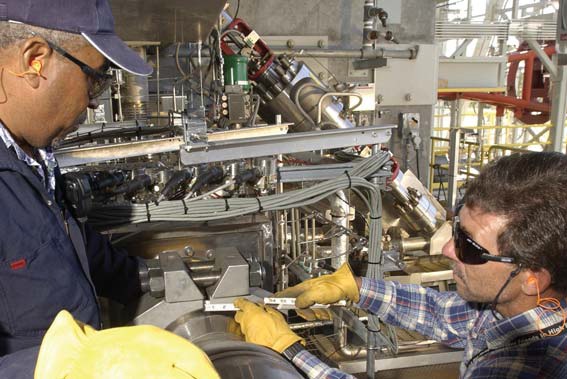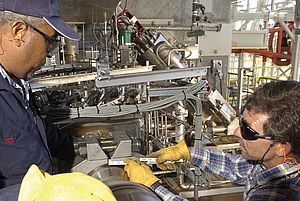For the NASA engineers at the Stennis Space Center, testing various rocket propulsion systems was getting expensive, as the high-pressure control valves used, needed to be switched out and replaced for each test. The NASA Stennis Space Center near Bay Saint Louis, Mississippi uses these valves, in both ambient and cryogenic configurations, for the flow control of oxygen, hydrogen, and other propulsion propellants used in their rocket engine and component test facilities. Stennis is famous as the main propulsion testing center for NASA, and is where the Space Shuttle main engines are tested and certified. Propulsion tests can include measurements of temperature, pressure, flow regulation, engine design validation, and material and component performance. Engineers at Stennis have historically employed inline, top-entry valves in these high-pressure performance tests because the top-entry design was perceived to limit external leakage. But inline, top-entry valves have their drawbacks. They are expensive and have long face-to-face lengths of up to six feet. NASA also needed the flexibility to change the trim size on its valves to meet the differing flow control requirements of individual tests. Since the trim size cannot be changed on the type of inline forged valves that NASA normally uses for these applications, NASA engineers were forced to stock multiple valves for a single test sequence for example, testing an engine or component using several propellant flow rates. When Failure Is Not an Option
To find a solution, NASA engineers turned to Flowserve’s Valtek Control Valve Products. The contact between NASA and Flowserve was originated through the Stennis Propulsion Test Directorate, which directs and manages the operational and engineering functions for rocket engine testing at Stennis. Considering the drawbacks of inline, top-entry valves, NASA engineers thought a solution might be to try an inline, split-body valve, which would allow them to change trim sizes without taking the valve out of service to meet testing requirements. If Flowserve could build a split-body valve for NASA, it would provide tremendous flexibility in testing and save on valve inventory expense. NASA engineers were cautiously optimistic. In their experience, split-body valves, particularly those used in cryogenic applications, were prone to external leakage and seat leakage. Additionally, in NASA’s high-pressure engine testing applications, engineers who wanted to use a split-body design were typically design-limited to an offset body as opposed to an inline design. This is because inline split-body valves typically have to use castings instead of forged body assemblies. NASA prefers inline valves because they are inherently easier to work with, as their body geometry enables simpler installation than that of offset valves. Valve Technology Is Rocket Science
To see if their idea would fly, field and design engineers from NASA and Flowserve worked to create a valve that would simplify installation and maintenance, allow for trim size changes, and minimize inventory requirements, thus reducing cost. Combining NASA’s vast experience with high pressure aerospace applications and Flowserve’s extensive application, design, and testing experience in the liquid natural gas, upstream oil and gas, and aerospace markets, the team generated a set of technical solutions that met NASA’s requirements for high-pressure, cryogenic, rocket propulsion tests. Because NASA’s requirements included both ambient and cryogenic applications, Flowserve began by integrating its leading-edge control valve technology into the valve’s seals, stem packing, and mechanical design for the required temperature ranges. In the first stage of the process, the body of the valve was divided into an upper and a lower section, with its seat ring sandwiched in between. To maintain the stem packing at an acceptable sealing temperature for cryogenic service, the design team added heat-absorbing fins to the upper body section of the valve. With the valve body made of stainless steel, project team engineers designed the seat ring in a nickel based alloy with a coefficient of thermal expansion less than that of the body material. This enabled the body surrounding the seat ring to contract more than the seat ring when the valve interior was cryogenically cooled, preventing external leakage at the body-seat joint. Engineers also machined the seat ring to have small, raised face sealing surfaces on both sides of the seal groove, which concentrate the body bolt-load over a small area and work to prevent external leakage. Preparing For Launch
The new valve’s body bolt-circle design is also different from those in conventional high pressure control valves, with half of the bolts clamping the split-body together from the top and half from the bottom. This design allows a short, clean flow path, minimizing frictional flow losses and shortening the face-to-face length of the valve. While conventional class 4500 valves with a nominal Cv of 120 have a face-to-face dimension greater than 100cm, the NASA-Flowserve split-body valve is only 65cm long. “This was an entirely collaborative and iterative process, with contributors from NASA and Flowserve providing their expertise and contributions to the success of this project,” says Michael Yentzen, an engineer on the project who is now a legislative affairs specialist at NASA headquarters in Washington, DC. “NASA trusted us as a cooperative partner to get them the solution they needed,” says Karlin Wilkes, Flowserve Valtek director, front line teams, and one of the engineers who worked on the project. “We solved every issue as it arose, getting input and feedback from NASA’s engineers during each step of the design process.” “You could truly call this a team effort,” says Wilkes. “We spent a year working together, and the end result has really paid off.” Mission Accomplished Pre-launch tests included cryogenic testing at Flowserve labs, then at Stennis, and then together in fi nal validation tests. At Stennis, the valve was bubble-tight at 776 barg, even at cryogenic temperatures. Following the design process, NASA ordered additional Flowserve split-body valves in varying sizes for other applications in the same system. The new applications for the additional split-body valves include transfer-line isolation and tank venting at Stennis. NASA has slated the new split-body design as a flow control valve in an RP-1 (refined petroleum) fuel run-line in a facility currently under construction at Stennis. “We’re very pleased with the product we developed,” adds Yentzen. “This valve design will save NASA a significant amount of money and will make rocket test operations at Stennis simpler and more efficient.” NASA engineers wrote up the results of the design process in a NASA Tech Brief, and are looking forward to working with Flowserve again. Flowserve engineers believe the new valve will have multiple applications across the aerospace and industrial gas industries, as well as in markets such as upstream oil and gas, and steel.
Valve technology development
in collaboration with NASA
- by Flowserve Corporation
- April 19, 2011
- 2391 views


















